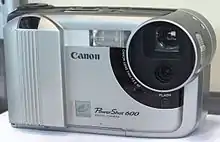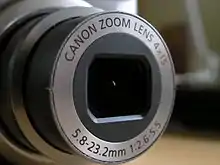Canon PowerShot
The PowerShot products is a line of consumer and prosumer grade digital cameras, launched by Canon in 1996.[3] In 1996 a model of PowerShot was introduced to the market, The PowerShot 600. The production of The PowerShot came shortly after Canon released and subsequently discounted its SV series in 1992 and switched to digital cameras. The PowerShot line has been successful for Canon, and is one of the best-selling digital camera lines worldwide. The PowerShot's success comes its marketing to the general public as a compact and easy to use digital camera.[4]

| Brand: | Canon |
|---|---|
| Model: | PowerShot 600 |
| First Mentioned: | 1996 |
| Resolution: | 832x608 |
| internal storage: | 1MB |
| Lens: | 7mm f/2.5 (equiv.50mm) |
| Size: | 159.5 x92.5 x58.8mm |
| Weight: | 420 gr. (just the camera) |

Free software from the Canon Hack Development Kit (CHDK) project allows nearly complete programmatic control of PowerShot cameras, enabling users to add features, up to and including BASIC and Lua scripting.[5]
Some models of PowerShot cameras were affected by third-party CCD sensors with a design flaw, which caused them to fail and display severely distorted images. Canon offered to repair affected cameras free of charge.[6]
Products


- Current
- D series: waterproof, freeze-resistant, and shock-resistant
- E series: design-oriented budget cameras
- G series: flagship cameras with advanced features
- S/SD series (also known as PowerShot Digital ELPH, Digital IXUS, and IXY Digital): "Performance and Style" ultra-compact point-and-shoot cameras
- S/SX series: ultra-zoom cameras
("IS" and "HS" are not a series; they are suffixes that denote "image stabilization" and "high sensitivity".)
- Discontinued
- S series: originally a series of compact point-and-shoot cameras, currently a series of prosumer cameras slotting beneath the G series
- A series: "Easy and Fun" budget cameras ranging from point-and-shoot to prosumer cameras
- PowerShot 600 (1996)
- Pro series: semi-professional-level cameras slotting right beneath Canon's dSLRs, consisting of the Pro70 (1998), Pro90 IS (2001), and Pro1 (2004)
- TX series: hybrid camera–camcorders
| Model | Release Date | Sensor specifications | Video specifications | Lens (35mm equiv), zoom and Aperture | Image Processor | LCD specifications | Viewfinder | Card | Size WxHxD (mm) | Weight
(with batteries) |
Notes |
|---|---|---|---|---|---|---|---|---|---|---|---|
| Powershot 600 | 13 June 1996 | 1 MP
832 x 608 1/3" CCD |
No movie mode | 50mm f/2.5 | No LCD | Optical | PCMCIA Type II / III (1MB Internal memory) | 160 x 93 x 59 | 460g | Canon's first consumer digital camera, has RAW | |
| Pro 70 | Early 1999 | 1.68 MP
1536 x 1024 1/2" CCD (CYGM) |
28-70mm (2.5x) f/2-2.4 | 2" vari-angle | Compact Flash Type I / II
(2 slots) |
148 x 84 x 130 | 800g | Added hotshoe | |||
| Pro 90 IS | February 2001 | 2.6 MP
1856 x 1392 1/1.8" CCD (CYGM) |
320x240 15fps | 37-370mm (10x) f/2.8-3.5 | 1.8" vari-angle | Electronic | Compact Flash Type I / II | 125 x 85 x 130 | 680g | Added movie mode | |
| Pro 1 | February 2004 | 8 MP
3264 x 2448 2/3" CCD |
640x480 15fps | 28-200mm (7x) f/2.4-3.5 | DIGIC | 2" vari-angle
235,000 |
118 x 72 x 90 | 640g | Has built in ND Filter |
See also
References
- "PowerShot 600". Canon Camera Museum.
- "Canon Powershot 600 (1996)". The Digital Camera Museum. Retrieved 2018-02-22.
- "Canon Camera Story (1992–1996) - From Analog SV Cameras to Digital Cameras". Canon. Archived from the original on July 17, 2011. Retrieved July 14, 2011. ()
- "View by period - 1992-1996 - Canon Camera Museum". global.canon. Retrieved 2022-09-15.
- Slashdot, Hacking Canon Point-and-Shoot Cameras, Posted by kdawson on Tuesday May 06 2008, @04:56PM, from the now-don't-brick-it dept.
- "Service Notice: CCD Image Sensor Advisory". 2005-10-06. Retrieved 2010-02-01.